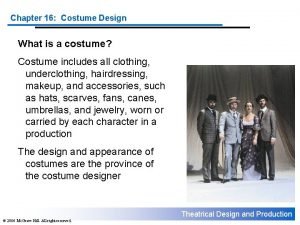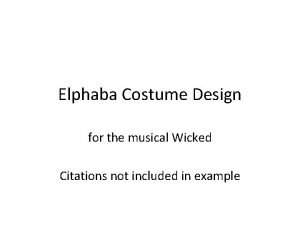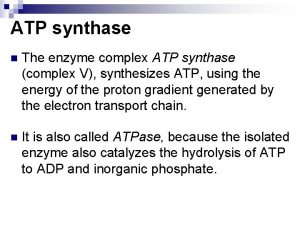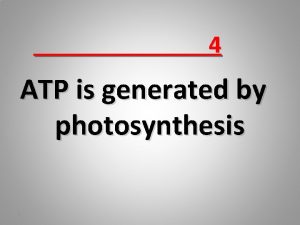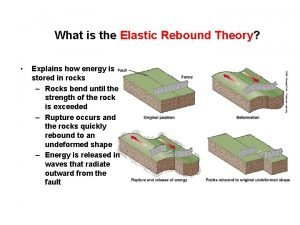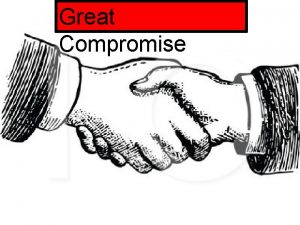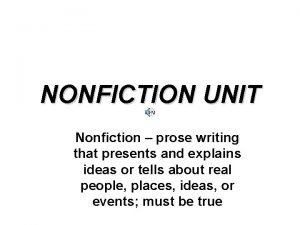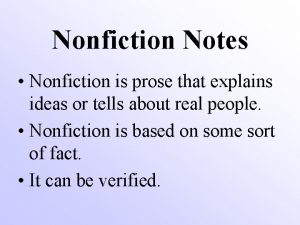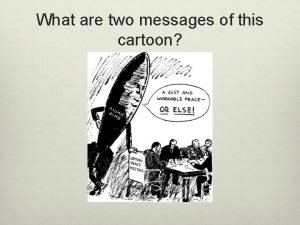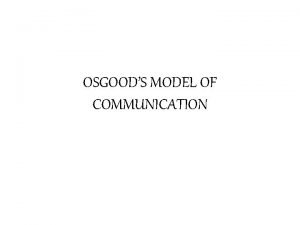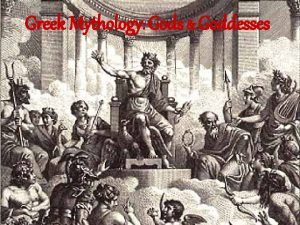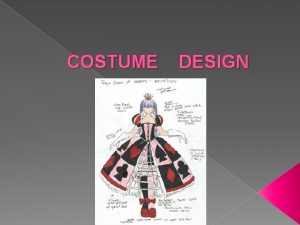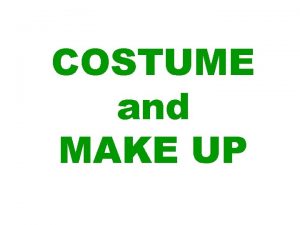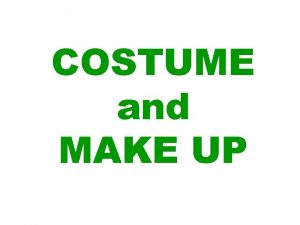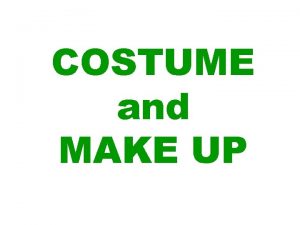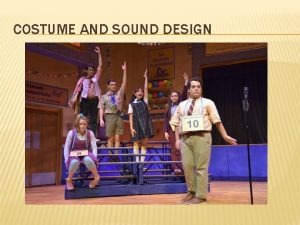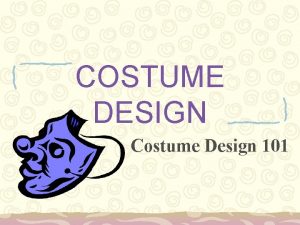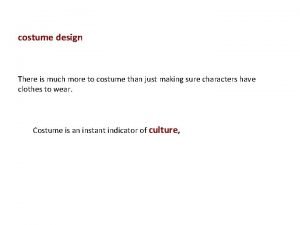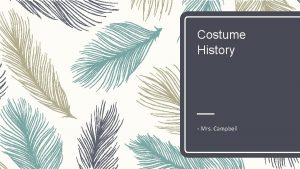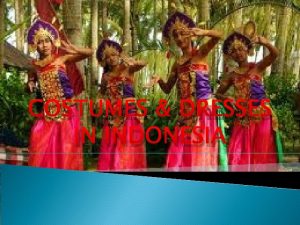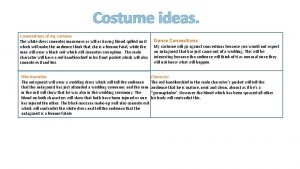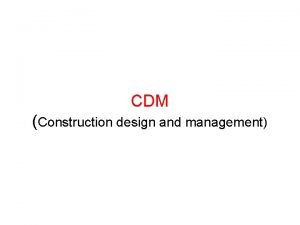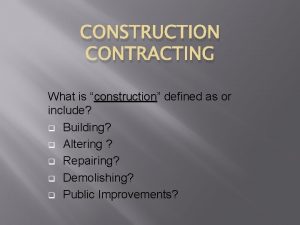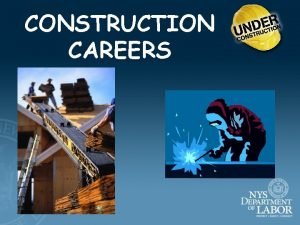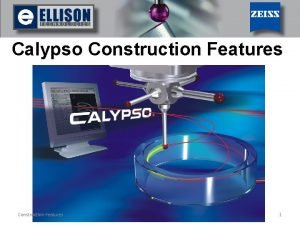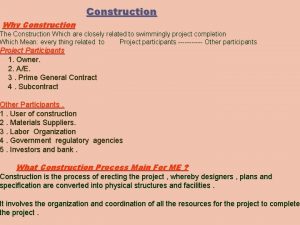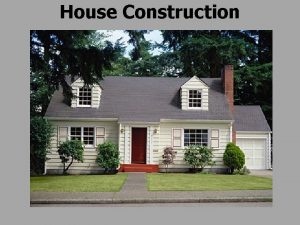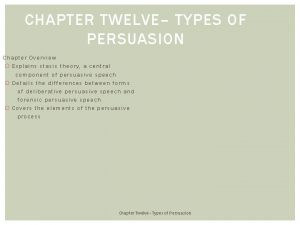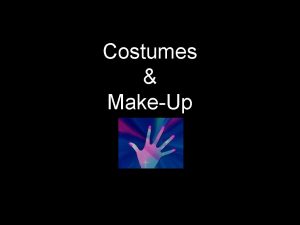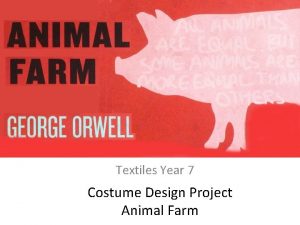Chapter 17 Costume Construction Costume Design Explains the































































- Slides: 63

Chapter 17: Costume Construction Costume Design – Explains the play’s characters Cues to emotional states / social rank / financial status Awareness of line, color, fabric, etc. Costume Construction – Making the design ‘live’ Responsible for building the designer’s creations Knowledge of the processes, materials , and techniques of construction Theatrical Design and Production © 2006 Mc. Graw-Hill. All right reserved.

Chapter 17: Costume Construction Concerns for costume construction… Costumes must be more durable than street clothes Capable of dealing with / expressing heightened emotional extremes Must accommodate a wide range of motion and rigor Theatrical Design and Production © 2006 Mc. Graw-Hill. All right reserved.

Chapter 17: Costume Construction Specific knowledge: The hand of fabrics Techniques of making and adjusting patterns Sewing Fabric painting Dyeing Distressing Specialty skills – making of jewelry / shoes / boots / wigs / armor Hand: The quality and characteristics of a fabric that can be evaluated or defined by a sense of touch Theatrical Design and Production © 2006 Mc. Graw-Hill. All right reserved.

Chapter 17: Costume Construction Organization of Costume Shops In process In performance Costume Designer Shop supervisor Wardrobe supervisor Shop crew or staff Wardrobe crew or staff Theatrical Design and Production © 2006 Mc. Graw-Hill. All right reserved.

Chapter 17: Costume Construction Costume Shop: Equipment Cutting Tables Used for laying out patterns and fabrics Surface needs to be smooth and also easy to push pins into Height – average person standing won’t need to bend to work Theatrical Design and Production © 2006 Mc. Graw-Hill. All right reserved.

Chapter 17: Costume Construction Costume Shop: Equipment Dress Forms Used for draping and pinning material Used for adjusting patterns Available in men’s and women’s sizes Theatrical Design and Production © 2006 Mc. Graw-Hill. All right reserved.

Chapter 17: Costume Construction Costume Shop: Equipment Fabric Storage should be easily labeled Organize by fabric type and color Often use ‘scrap’ pieces or use original fabrics to make alterations Need space for bolts of fabric and large rolls of brown paper as well Theatrical Design and Production © 2006 Mc. Graw-Hill. All right reserved.

Chapter 17: Costume Construction Costume Shop: Equipment Washing Machine and Dryer Used for standard purposes as well as dyeing fabrics Requires a heavy-duty machine – lots of wear and tear Continual cleaning to ensure that dyes do not remain in washer or dryer and ruin other clothing! Theatrical Design and Production © 2006 Mc. Graw-Hill. All right reserved.

Chapter 17: Costume Construction Costume Shop: Equipment Dye Vat Commercial = expensive Soup kettles = cheap and workable! Needed to heat large quantities of fabric and liquid to achieve an even coloring of dyed fabric Theatrical Design and Production © 2006 Mc. Graw-Hill. All right reserved.

Chapter 17: Costume Construction Costume Shop: Equipment Hot Plate Smaller alternative to a dye vat Works well with smaller amounts of fabric Theatrical Design and Production © 2006 Mc. Graw-Hill. All right reserved.

Chapter 17: Costume Construction Costume Shop: Equipment Stove Residential stove will work Can be used for heating water Also useful when dealing with plastics or other materials for accessories Theatrical Design and Production © 2006 Mc. Graw-Hill. All right reserved.

Chapter 17: Costume Construction Costume Shop: Equipment Irons Need heavy-duty irons to work with many fabrics Last longer if industrial as well Steam irons are also used Use distilled water – prevent mineral build-up and possible stains Theatrical Design and Production © 2006 Mc. Graw-Hill. All right reserved.

Chapter 17: Costume Construction Costume Shop: Equipment Ironing Boards Once again – heavy-duty, industrial versions are preferable Specialty boards for sleeve boards and/or needle boards are also good to have in the shop Theatrical Design and Production © 2006 Mc. Graw-Hill. All right reserved.

Chapter 17: Costume Construction Costume Shop: Equipment Steamer Use to take wrinkles out of heavy materials such as velvets, velour, and corduroys. . Also used for millinery Theatrical Design and Production © 2006 Mc. Graw-Hill. All right reserved.

Chapter 17: Costume Construction Costume Shop: Equipment Sink Need hot and cold water! Variety of uses Theatrical Design and Production © 2006 Mc. Graw-Hill. All right reserved.

Chapter 17: Costume Construction Costume Shop: Equipment Mirror Full-length, three-way mirror needed for fittings Want to see costume from all directions to insure correct fit Theatrical Design and Production © 2006 Mc. Graw-Hill. All right reserved.

Chapter 17: Costume Construction Costume Shop: Equipment Racks Useful for transporting clothing from shop to various locations in theatre Provides mobile hanging location Theatrical Design and Production © 2006 Mc. Graw-Hill. All right reserved.

Chapter 17: Costume Construction Costume Shop: Equipment Tables & Chairs Needed for hand sewing and detail work – often requires many hours in sitting position Consider the comfort of your workers and craftspeople! Theatrical Design and Production © 2006 Mc. Graw-Hill. All right reserved.

Chapter 17: Costume Construction Costume Shop: Equipment Sewing Machines Straight-Stitch Sewing Machines Zigzag Sewing Machines Walking-Foot Machine (a. k. a. power machines) Serger (a. k. a. merrow machine or overlock) Blind-Stitch Machine Theatrical Design and Production © 2006 Mc. Graw-Hill. All right reserved.

Chapter 17: Costume Construction Costume Shop: Sewing Equipment Common hand tools Measuring devices Hand needles Machine needles Thread Thimbles Tracing wheels Tracing paper Tailor’s chalk Shears & Scissors Seam Rippers Single-edged razor blades Hot Glue Gun Theatrical Design and Production © 2006 Mc. Graw-Hill. All right reserved.

Chapter 17: Costume Construction Costume Shop: Sewing Equipment Common fasteners Straight pins Safety pins Push pins Snaps Hooks & Eyes Zippers Velcro Seam-Binding Tape Buttons Theatrical Design and Production © 2006 Mc. Graw-Hill. All right reserved.

Chapter 17: Costume Construction Fabrics Each fabric has its own intrinsic characteristics The hand of the fabric is used to determine a fabric’s suitability for a particular costume Hand of the fabric = Type of fiber Weave or structure of fabric Treatment of fabric Finish of fabric Theatrical Design and Production © 2006 Mc. Graw-Hill. All right reserved.

Chapter 17: Costume Construction Fabrics 2 types of textile fibers Natural Synthetic Cotton Linen Silk Wool Acrylic Nylon Polyester Rayon Acetate Theatrical Design and Production © 2006 Mc. Graw-Hill. All right reserved.

Chapter 17: Costume Construction Fabrics Cotton White natural fiber contained in the seed pod, or boll, of the cotton plant Breathes (ability to transmit heat, air, and water vapor) well – good for performers Accepts dyes well Blend – combination of more than one type of fiber, blends are created to take advantage of the best properties of all fibers in the blend. Wrinkles easily Large number of weaves and blends available Mercerization – soda treatment applied to cotton which swells and straightens fibers Theatrical Design and Production © 2006 Mc. Graw-Hill. All right reserved.

Chapter 17: Costume Construction Fabrics Linen Oldest textile fabric known Comes from flax Stronger than cotton Silky luster Good conductor of heat Lint-free Hard to dye and/or stain Washes easily Shrinks and creases easily Theatrical Design and Production © 2006 Mc. Graw-Hill. All right reserved.

Chapter 17: Costume Construction Fabrics Silkworms spin cocoons – creates silk Expensive / Strong Lightweight / Pliable Good elasticity / Lustrous Holds heat / Dyes well Wild silk – brown with a rougher texture Cultivated silk– Smoother texture and grayish-yellow color Cultivation 1. Reeling – stronger & more lustrous 2. Spinning – Shorter and twists the fibers more Theatrical Design and Production © 2006 Mc. Graw-Hill. All right reserved.

Chapter 17: Costume Construction Fabrics Wool Made from the fleece of sheep 2 main types 1. Woolen: Loosely twisted, soft, and weak / fuzzy textured surface / works as an insulator – traps heat 2. Worsted: Tightly twisted, stronger, and smoother surface / breathes well Absorbs moisture & dyes Shrinks!!! Wrinkles will disappear if the material is hung up – will hang out Can be shaped with steam Theatrical Design and Production © 2006 Mc. Graw-Hill. All right reserved.

Chapter 17: Costume Construction Fabrics Synthetic Fabrics Chemical compounds changed into hardened filaments through patented processes Tend to be slick, smooth, and dense Do not breathe like natural fibers – tend to trap body heat Durable Resistant to wrinkles Often costume designers will use blends of synthetic and natural fibers to create garments that have the best of both worlds (50% blends of natural and synthetic tend to breathe well but hold up to theatrical demands!) Important to know the fabric type & blend to care for the garment once made!!! Theatrical Design and Production © 2006 Mc. Graw-Hill. All right reserved.

Chapter 17: Costume Construction Fabrics Synthetic Fabrics: Acrylic Compound based on coal, petroleum, & other materials Soft & lightweight Does not dye well in shops but factory dyed acrylics are colorfast Wrinkle-resistant Little ironing needed Common trade names: Acrilan, Orlon, Creslan Theatrical Design and Production © 2006 Mc. Graw-Hill. All right reserved.

Chapter 17: Costume Construction Fabrics Synthetic Fabrics: Nylon A slurry of air, water, and coal produces the continuous-filament fiber known as nylon Light, strong, elastic, & resistant to abrasion Virtually no wrinkles Generally does not conduct moisture or heat well Various weaves – smooth, tight (Trap heat) – loose, open (Don’t trap heat) – Some dye well some do not Common trade names: Antron, Capriolan, Qiana Theatrical Design and Production © 2006 Mc. Graw-Hill. All right reserved.

Chapter 17: Costume Construction Fabrics Synthetic Fabrics: Polyester Petroleum-based product Highly resistant to wrinkling Extremely strong, commercially colorfast, reasonably stain-resistant (Does not dye well in shop surroundings) Used in a variety of fabrics and blends Common trade names: Dacron, Kodel, Quintess Theatrical Design and Production © 2006 Mc. Graw-Hill. All right reserved.

Chapter 17: Costume Construction Fabrics Synthetic Fabrics: Rayon One of the 1 st synthetic fabrics Regenerated cellulose – cotton linters and wood pulp… Dyes easily, excellent colorfastness, bends well with other fabrics, & very absorbent Similar to silk (low-cost alternative) Common trade names: Avril, Celanese, Fibro, Zantrel Theatrical Design and Production © 2006 Mc. Graw-Hill. All right reserved.

Chapter 17: Costume Construction Fabrics Synthetic Fabrics: Acetate Similar to rayon – regenerated cellulose solution Little strength, require low heat iron, don’t hold crease well Good draping characteristics & wrinkle resistance Triacetates – better than acetates – have virtues with less issues Theatrical Design and Production © 2006 Mc. Graw-Hill. All right reserved.

Chapter 17: Costume Construction Fabrics Weaves How the fabric is created – generates a variety of different textures and patterns Threads running the length of the fabric = warp Threads running the width of the fabric = weft / woof / fill Theatrical Design and Production © 2006 Mc. Graw-Hill. All right reserved.

Chapter 17: Costume Construction Fabrics Weaves Types of weaves… Plain Basket Twill (most durable weave) Satin (appears lustrous) Pile (plush texture) Plain Knit (interlocking loops) Theatrical Design and Production © 2006 Mc. Graw-Hill. All right reserved.

Chapter 17: Costume Construction Fabrics A variety of fabrics are used in costume construction – a basic list… Brocade – Slightly raised pattern – various weights – reflexive surface Buckram – Foundation for millinery and other stiff garments Canvas – Used mainly for lining or when durability is focus Chiffon – Sheer – Soft diaphanous draping qualities Corduroy – Has ridges – does not drape – low-cost sub for velvet/velour Crepe – Low luster, soft drape – lingerie, blouses or flowing gowns Crinoline – Has permanent sizing for stiffness Denim – Blue-jeans and working clothes Drill – smoother & more luster than denim Felt – Primarily used for hats and trimming Flannel – Men’s & women’s suits, trousers, & shirts Gabardine – Inexpensive suits & outerwear Theatrical Design and Production © 2006 Mc. Graw-Hill. All right reserved.

Chapter 17: Costume Construction Fabrics A variety of fabrics are used in costume construction – a basic list cont… Jersey – Knit fabric with draping qualities Linen – Nubby, soft-luster surface – tropical suits & sportswear Muslin – Plain, durable cotton – lining material & making patterns Net – Stiff, very-open-weave – Ballet skits & veils Pellon – Non-woven stiffening material - petticoats Sateen – Satin-weave lining material Satin – High-luster satin-weave – evening gowns to draperies Taffeta – Used extensively in 18 th & 19 th century gowns Moiré taffeta – Taffeta with a nonrepetitive pattern pressed into the surface Velour – Pile-weave fabric – Heavy weight (upholstery & drapes) Light weight (sportswear) Velvet – Drapes well, lustrous – evening gowns to capes Theatrical Design and Production © 2006 Mc. Graw-Hill. All right reserved.

Chapter 17: Costume Construction Fabrics Finishes Functional Finishes 1. Permanent-press – reduces wrinkles in fabric and puts in permanent creases 2. Mercerization – adds strength & shine to cotton thread 3. Flameproofing – chemical process – prevents cloth from supporting flames 4. Preshrunken – has been bathed in water 5. Anti-bacterial agents – reduces stains from natural substances such as sweat Decorative Finishes Alter the appearance of the fabric – bleaching, dyeing, printing, texturing… Finishes are applied to fabric before they leave the mill although some finishes are applied in costume shops! Theatrical Design and Production © 2006 Mc. Graw-Hill. All right reserved.

Chapter 17: Costume Construction Nonfabric Materials Leather Used for hats, shoes, & period pieces such as vests, armor, and belts Usually treated cowhide (in U. S. ) Smooth & rough side Can be dyed & stitched Tools for leather working – awls, leather punches, etc. Theatrical Design and Production © 2006 Mc. Graw-Hill. All right reserved.

Chapter 17: Costume Construction Nonfabric Materials Sculptural Arts Coatings Made in North Caroline – water-based, low-emissivity craft products, paints, & finishes - bonds materials together to create anything needed! Theatrical Design and Production © 2006 Mc. Graw-Hill. All right reserved.

Chapter 17: Costume Construction Nonfabric Materials Plaster Bandage Plaster-impregnated gauze – make items from forms such as masks, small armor pieces, etc. Same material used to make casts Water soluble – no toxic or noxious fumes – forms easily Once dry, can be sanded or painted Theatrical Design and Production © 2006 Mc. Graw-Hill. All right reserved.

Chapter 17: Costume Construction Nonfabric Materials Thermoplastics Stiff plastics that soften in hot water to then be molded Pellet, mesh, and fabric forms Masks, armor, etc. Can be finished with most paints Theatrical Design and Production © 2006 Mc. Graw-Hill. All right reserved.

Chapter 17: Costume Construction Nonfabric Materials Fiberglass 2 Forms: 1. Glass fibers in form of mat or woven cloth 2. Resin coat that cures into hard plastic Used to make armor and helmets Resin can be used alone in production of jewelry Theatrical Design and Production © 2006 Mc. Graw-Hill. All right reserved.

Chapter 17: Costume Construction Nonfabric Materials Metal Aluminum, copper, and brass appliqués and jewelry are often used in construction of bodices, gowns, armor, buckles, etc. Metals are often attached using pop rivets or special adhesives… Theatrical Design and Production © 2006 Mc. Graw-Hill. All right reserved.

Chapter 17: Costume Construction Garment construction Theatre costumes vs. the garment industry Single, perfect fit version vs. multiple copies of one garment Built to last for production vs. built to last as long as possible Costume design is geared around creating character – not creating a ‘saleable’ garment Theatrical Design and Production © 2006 Mc. Graw-Hill. All right reserved.

Chapter 17: Costume Construction Garment Construction: Patterns 3 Main goals… 1. Manipulate a flat piece of cloth by cutting and shaping so it conforms to a specific three-dimensional body 2. Accurately translating the costume designer’s rendering 3. Creating a costume that serves the needs of the script, actor, production, etc. 2 Main methods… 1. Flat patterning (drafting) 2. Draping Theatrical Design and Production © 2006 Mc. Graw-Hill. All right reserved.

Chapter 17: Costume Construction Garment Construction: Patterns Flat Patterning Get actor measurements Use measurements to develop basic pattern – a. k. a. the body block / block Transfer paper pattern to muslin and stitch garment together Actor comes in for fittings – Adjustments are made Costume pattern developed from the modified block Muslin mock-up fitted to the actor for more adjustments Construct final garment Final fittings for performer Cutter of the pattern must be familiar with the designer’s concepts as well as historical patterns for clothing – has to be able to translate research into practical application Theatrical Design and Production © 2006 Mc. Graw-Hill. All right reserved.

Chapter 17: Costume Construction Garment Construction: Patterns Actor Measurements include: Traditional clothes sizing Specific measurements that involve various segments of the performer’s body – Arm length to wrist Bicep Armseye Underbust to waist Etc. – See book pg. 439! Theatrical Design and Production © 2006 Mc. Graw-Hill. All right reserved.

Chapter 17: Costume Construction Garment Construction: Patterns Draping Process of pinning fabric directly to the tailor’s form and creating pattern pieces or a garment by manipulating the fabric until the desired look is achieved Requires a dress form that is padded/altered to match the performer’s exact measurements Traditionally used to create non-tailored elements Sometimes creates a mock version but often works to build the garment without mock version as fabric drape is essential to this type of creation process Theatrical Design and Production © 2006 Mc. Graw-Hill. All right reserved.

Chapter 17: Costume Construction Garment Construction: Patterns Pattern-Drafting Software With computers, cutters can use software to develop patterns Cannot be used for draping Learning curve with the software – cutter must know how to really use the software for it to be useful! Sample software: Custom Pattern Maker Requires a plotter to print adequately Theatrical Design and Production © 2006 Mc. Graw-Hill. All right reserved.

Chapter 17: Costume Construction Special-Effects Treatment of Fabrics Fabric Dyeing Safety 1 st! Look at the MSDS information to be sure you are handling any and all materials correctly! Types of dyes must know setting agent as well as time, saturation, & heat needs Union Dyes – Household dyes such as RIT – made to be moderately effective – not particularly effective on synthetic materials Aniline Dyes – a. k. a. unified aniline dyes or acid dyes – Strong colors w/ light to full saturation – good with natural fibers & some synthetics Disperse Dyes – Intense colors – almost colorfast if dyed when dye is at boiling point – designed for use with synthetics Fiber-Reactive Dyes – Most useful for fabric painting with natural fibers – Uses cool or lukewarm water Theatrical Design and Production © 2006 Mc. Graw-Hill. All right reserved.

Chapter 17: Costume Construction Special-Effects Treatment of Fabrics Fabric Painting Painted to add texture / enhance 3 D qualities / Age Fabric / Create or reinforce a pattern Fabric painting can be done with a variety of materials – dyes, fabric paints, spray enamels, French enamel varnish, shellac, bronzing powders, etc. – and a variety of applicators – brushes, sponges, spray guns, air brushes, stencils, hot glue guns, etc. – Read MSDS to make certain you know safety procedures for application and later treatment of the garment!!! Theatrical Design and Production © 2006 Mc. Graw-Hill. All right reserved.

Chapter 17: Costume Construction Special-Effects Treatment of Fabrics Costume Aging Sometimes, it is necessary to distress a garment – showing its age, abuse, and wear-and-tear Distress appears where fabric receives greatest stress – elbows, knees, seat, etc. Distress can be created by overstretching a garment, painting it, ripping or shredding the fabric… Experience is the best teacher! Experiment!!! Theatrical Design and Production © 2006 Mc. Graw-Hill. All right reserved.

Chapter 17: Costume Construction Accessory Construction Wigs… Allows designer to achieve correct hair style – especially important with period costuming Rent or make – wigmaking is a difficult craft! Restyle contemporary wigs to look like period is also a low-cost alternative To make a commercial wig appear more natural, 1/3 of the hair is removed and is then used to ventilate a piece of netting attached to the wig’s foundation – this creates a more realistic hairline… Also hair extensions and pieces are used to supplement a performer’s natural hair Theatrical Design and Production © 2006 Mc. Graw-Hill. All right reserved.

Chapter 17: Costume Construction Accessory Construction Wigs… Some period styles that require the use of wigs, extensions, or pieces to create… Theatrical Design and Production © 2006 Mc. Graw-Hill. All right reserved.

Chapter 17: Costume Construction Accessory Construction Millinery… Hats often provide the completing element for period costume… Many hats can be created from a basic broad-brimmed, deepcrowned felt hat Steaming allows hats to be shaped and molded as needed – using a hat mold or hat block… Also buckram is used to help create hats Theatrical Design and Production © 2006 Mc. Graw-Hill. All right reserved.

Chapter 17: Costume Construction Accessory Construction Millinery… Some period styles that require hats or headpieces to complete the ‘look’ of the particular period… Theatrical Design and Production © 2006 Mc. Graw-Hill. All right reserved.

Chapter 17: Costume Construction Accessory Construction Footwear… Appropriate footwear makes a costume complete… Ideal solution is to contract with a cobbler or shoe company but that is not cost effective Usually shops add elements to existing shoes to create the illusion of a period piece Soft- and hard-soled house slippers are a common base for building shoes – usually leather additions and other accessories provide the rest of the illusion… Theatrical Design and Production © 2006 Mc. Graw-Hill. All right reserved.

Chapter 17: Costume Construction Accessory Construction Footwear… A progression of footwear styles over the course of history… Theatrical Design and Production © 2006 Mc. Graw-Hill. All right reserved.

Chapter 17: Costume Construction Accessory Construction Jewelry… Simplicity and exaggeration combine to create stage jewelry… Know your research to create something that looks correct Wood, plastics, metals, and more can be used to create jewelry Attaching cording and trim, painting the object, and applying rhinestones adds to the illusion All shops should have a collection of ‘junk jewelry’ – rings, brooches, necklaces, and similar pieces that look gaudy up close often look rich and elegant from stage… Theatrical Design and Production © 2006 Mc. Graw-Hill. All right reserved.

Chapter 17: Costume Construction Accessory Construction Armor… Breastplates and helmets are often made from Fabric Form, fiberglass, thermoplastics, leather, etc. Most armor requires a form or armature that is made of clay & wire… The form is covered with foil or some other no-stick material… The material making the armor is applied to that, making a rigid shell Then apply decoration to suit the character If using thermoplastics, insulate the actor and mold directly on the body to ensure a good fit… Theatrical Design and Production © 2006 Mc. Graw-Hill. All right reserved.

Chapter 17: Costume Construction Accessory Construction Masks… Another major element of design, masks can be made in a variety of ways… Papier-mâché – plaster bandages – Fabric Form – fiberglass – Thermoplastics… Often, molds are made of the performer’s face and then the mask is formed from that ‘cast’ Once built, masks are decorated and/or painted to express character as needed Theatrical Design and Production © 2006 Mc. Graw-Hill. All right reserved.

Chapter 17: Costume Construction Accessory Construction Masks… Papier-mâché process 1 1. Life-mask made and covered with aluminum foil 2 2. Apply glue-soaked strips of paper to mask 3. Allow to dry for 24 -48 hrs. 4. Finish as desired 3 4 Theatrical Design and Production © 2006 Mc. Graw-Hill. All right reserved.
 Julie taymor costume design
Julie taymor costume design What is a costume
What is a costume Costume design wicked
Costume design wicked Hát kết hợp bộ gõ cơ thể
Hát kết hợp bộ gõ cơ thể Bổ thể
Bổ thể Tỉ lệ cơ thể trẻ em
Tỉ lệ cơ thể trẻ em Gấu đi như thế nào
Gấu đi như thế nào Thang điểm glasgow
Thang điểm glasgow Hát lên người ơi
Hát lên người ơi Môn thể thao bắt đầu bằng chữ đua
Môn thể thao bắt đầu bằng chữ đua Thế nào là hệ số cao nhất
Thế nào là hệ số cao nhất Các châu lục và đại dương trên thế giới
Các châu lục và đại dương trên thế giới Công thức tính thế năng
Công thức tính thế năng Trời xanh đây là của chúng ta thể thơ
Trời xanh đây là của chúng ta thể thơ Cách giải mật thư tọa độ
Cách giải mật thư tọa độ Làm thế nào để 102-1=99
Làm thế nào để 102-1=99 độ dài liên kết
độ dài liên kết Các châu lục và đại dương trên thế giới
Các châu lục và đại dương trên thế giới Thơ thất ngôn tứ tuyệt đường luật
Thơ thất ngôn tứ tuyệt đường luật Quá trình desamine hóa có thể tạo ra
Quá trình desamine hóa có thể tạo ra Một số thể thơ truyền thống
Một số thể thơ truyền thống Cái miệng bé xinh thế chỉ nói điều hay thôi
Cái miệng bé xinh thế chỉ nói điều hay thôi Vẽ hình chiếu vuông góc của vật thể sau
Vẽ hình chiếu vuông góc của vật thể sau Biện pháp chống mỏi cơ
Biện pháp chống mỏi cơ đặc điểm cơ thể của người tối cổ
đặc điểm cơ thể của người tối cổ Thứ tự các dấu thăng giáng ở hóa biểu
Thứ tự các dấu thăng giáng ở hóa biểu Vẽ hình chiếu đứng bằng cạnh của vật thể
Vẽ hình chiếu đứng bằng cạnh của vật thể Phối cảnh
Phối cảnh Thẻ vin
Thẻ vin đại từ thay thế
đại từ thay thế điện thế nghỉ
điện thế nghỉ Tư thế ngồi viết
Tư thế ngồi viết Diễn thế sinh thái là
Diễn thế sinh thái là Các loại đột biến cấu trúc nhiễm sắc thể
Các loại đột biến cấu trúc nhiễm sắc thể Số nguyên là gì
Số nguyên là gì Tư thế ngồi viết
Tư thế ngồi viết Lời thề hippocrates
Lời thề hippocrates Thiếu nhi thế giới liên hoan
Thiếu nhi thế giới liên hoan ưu thế lai là gì
ưu thế lai là gì Khi nào hổ mẹ dạy hổ con săn mồi
Khi nào hổ mẹ dạy hổ con săn mồi Khi nào hổ con có thể sống độc lập
Khi nào hổ con có thể sống độc lập Sơ đồ cơ thể người
Sơ đồ cơ thể người Từ ngữ thể hiện lòng nhân hậu
Từ ngữ thể hiện lòng nhân hậu Thế nào là mạng điện lắp đặt kiểu nổi
Thế nào là mạng điện lắp đặt kiểu nổi Buoyancyability
Buoyancyability Text structure cause and effect definition
Text structure cause and effect definition Chemiosmotic hypothesis explains
Chemiosmotic hypothesis explains Chemiosmotic hypothesis explains
Chemiosmotic hypothesis explains The elastic rebound theory
The elastic rebound theory How something works
How something works Great compromise chart
Great compromise chart Tells how something works or why something happens
Tells how something works or why something happens This type of writing explains things.
This type of writing explains things. The condensation sequence theory explains why
The condensation sequence theory explains why Prose writing that presents and explains ideas
Prose writing that presents and explains ideas What is nonfiction prose
What is nonfiction prose Which type of essay explains, informs, defines?
Which type of essay explains, informs, defines? What is the message of this cartoon
What is the message of this cartoon Advantages of osgood and schramm model
Advantages of osgood and schramm model What is aphrodite's roman name
What is aphrodite's roman name Olympian family tree
Olympian family tree Writing that explains
Writing that explains Jeopardy romeo and juliet
Jeopardy romeo and juliet

